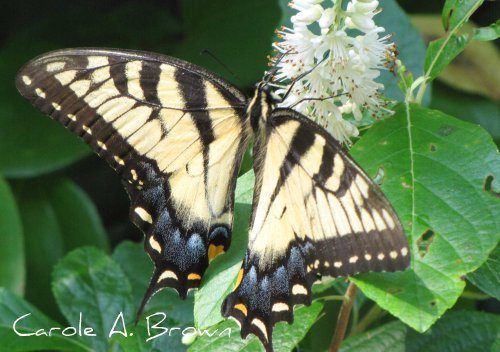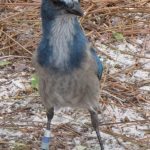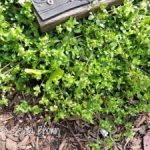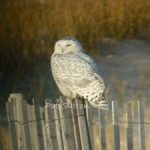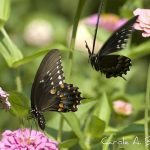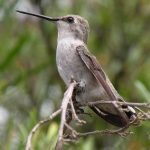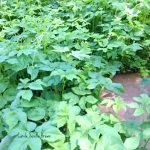There are many similar or related terms to Ecosystem Gardening being used which may be causing some confusion. These terms include: organic gardening, habitat gardening for wildlife, ecological gardening, sustainable landscaping/gardening, xeriscaping, natural gardening, and more. For the purpose of clarity, I’ll discuss these terms and their relation to Ecosystem Gardening so that we will develop a more specific definition of Ecosystem Gardening.
Sustainable Landscaping and Sustainable Gardening
Sustainability in landscaping and gardening usually refers to the use of resources and materials. The resources category is devoted to appropriate irrigation, stormwater management, soil health, and reduction in the use of fossil fuels.
The materials category refers to using locally available, sustainably harvested and produced materials, such as using porous paving materials to control stormwater runoff, using certified sustainably harvested lumber, using recycled materials and those made from recycled materials. Lawn reduction is often a goal of sustainable landscaping.
We will use a definition of sustainability proposed by the Council of Educators in Landscape Architecture (CELA), and quoted in the book Sustainable Landscape Construction:
Sustainable landscapes contribute to human well-being and at the same time are in harmony with the natural environment. They do not deplete or damage other ecosystems. While human activity will have altered native patterns, a sustainable landscape will work with native conditions in its structure and functions. Valuable resources—water, nutrients, soil, etc—and energy will be conserved, diversity of species will be maintained or increased.
I like this definition because it includes diversity of species and harmony with the natural environment.
Organic Gardening
Organic gardening usually refers to eliminating the use of chemical fertilizers, herbicides, and pesticides. This is a term usually used in the growing of food, like organic fruits and vegetables. Organic gardening often includes integrated pest management and adaptive management techniques.
Organic gardening has been brought to people’s attention through the efforts of Rodale Press and their many books on the subject, and they should be congratulated for their efforts in this area. However, a word of caution is necessary here because they have also published a series of books about attracting birds and butterflies to your garden.
You need to remember that organic doesn’t necessarily mean non-invasive, and caution must be observed when using any plant they recommend. I am not advocating the exclusion of all exotic plants, but any book that recommends invasive plants is off my list. Always check with your local DNR or county extension about a plant’s invasive status before purchasing or planting, no matter what book published by a trusted source says. Many of these books continue to suggest invasive plants to attract birds and butterflies.
Habitat Gardening for Wildlife
There are many books devoted to attracting birds and butterflies to your garden that use the term habitat gardening. Many of these books take what I call the Chinese Restaurant approach: pick two plants from column A and one from column B and voila, you have a habitat garden. This seems like just a specimen approach, kind of like a plant zoo.
Most of these books spend very little time discussing actual gardening, opting instead to devote most of their pages to bird feeders, bird seed, and special “projects” for the birders garden, such as using cookie cutters to make special shapes from stale bread to hang among your shrubs. My biggest problem is that most of these books recommend many invasive plants that do not belong in any garden.
It should be noted that a “habitat” refers to those resources and conditions necessary for the survival of one species at a given point in time. The habitat for reproductive success may differ completely from that used at other times of the year. This should not be confused with “habitat type,” which refers only to the vegetative structure and composition of a site. A habitat is species specific, which means that your garden may contain many habitats.
You can choose plants and garden elements that contribute to the habitat of many species and you can plan habitats for specific species, for example by creating a habitat for one species of endangered butterfly, bird, amphibian, or pollinator.
Natural Gardening
Natural gardening usually combines organic gardening (the elimination of chemical fertilizers, pesticides, and herbicides) with habitat gardening and also seeks to make gardens that mimic the structure of natural areas.
Natural gardening does not make a distinction between native, exotic, or invasive plants. The goal is to create natural looking gardens. Gardens that mimic the structure of our remaining wild areas create many benefits for the wildlife around you.
Xeriscaping
Xeriscaping usually refers to using plants that are appropriate for the amount of rainfall you receive so that supplemental irrigation is not necessary. Particularly in dry areas, xeriscaping is necessary to conserve water, a very precious resource in areas like Arizona, Southern California, and west Texas.
Serious drought has been affecting other areas of the country. Xeriscaping can be used by selecting drought tolerant plants which will not need to be watered. Locally native plants are often used because these plants are adapted to the moisture levels present in your locale.
Water conservation is the primary goal of xeriscaping.
Ecological Gardening
Ecological gardening is based on plant communities, grouping plants together based on their moisture, sunlight and soil condition needs. Native plants form the backbone of these communities and are chosen to benefit wildlife, such as native pollinators, birds, and butterflies. Plants that meet human needs, such as food, flowers, herbs, and medicine are also of primary importance.
The emphasis of ecological gardening is often on food production, seeking to reduce the distance food travels from harvest to your table, and therefore reduce consumption of fossil fuel. Organic methods and permaculture are hallmarks of this approach.
So ecological gardening has combined sustainability, organic methods, habitat creation, and permaculture into a focus on your garden as an ecosystem that is able to supply your family food.
Ecosystem Gardening
Ecosystem Gardening is a combination of all of the above, with an emphasis on creating welcoming habitats for wildlife.
Ecosystem Gardening is:
- Sustainable Landscaping—conserving natural resources like healthy topsoil, and clean water, reducing the use of fossil fuels, managing rainwater where it falls, composting garden waste onsite to keep it out of landfills, and wisely choosing local, recycled or sustainable materials.
- Organic Gardening—the use of chemical fertilizers, herbicides, and pesticides is harmful to wildlife, humans, and the environment. Organic methods have shown that these are not necessary
- Habitat Gardening—native plants are an absolute necessity in creating habitats for wildlife.
- Natural Gardening—mimicking the structure and function of natural areas in our gardens can create an aesthetically pleasing vertical view for you and for wildlife, and contribute to ecosystem services and functions.
- Ecological Gardening—knowing that your garden is indeed an ecosystem that provides much needed habitats for wildlife and creating plant communities based on similar soil, light, and moisture requirements.
The goal of Ecosystem Gardening is to incorporate elements from all of the above gardening styles into a coherent practice that benefits wildlife, provides beauty for you, conserves natural resources, and makes the world a better place.
Many species of wildlife are declining because of the human action of habitat loss, degradation, and fragmentation. You can “give a little back to wildlife” by choosing to manage your property in a way which supports and welcomes wildlife. You can learn to share your place with the wildlife around you.
More From Ecosystem Gardening:
Submit your review | |

